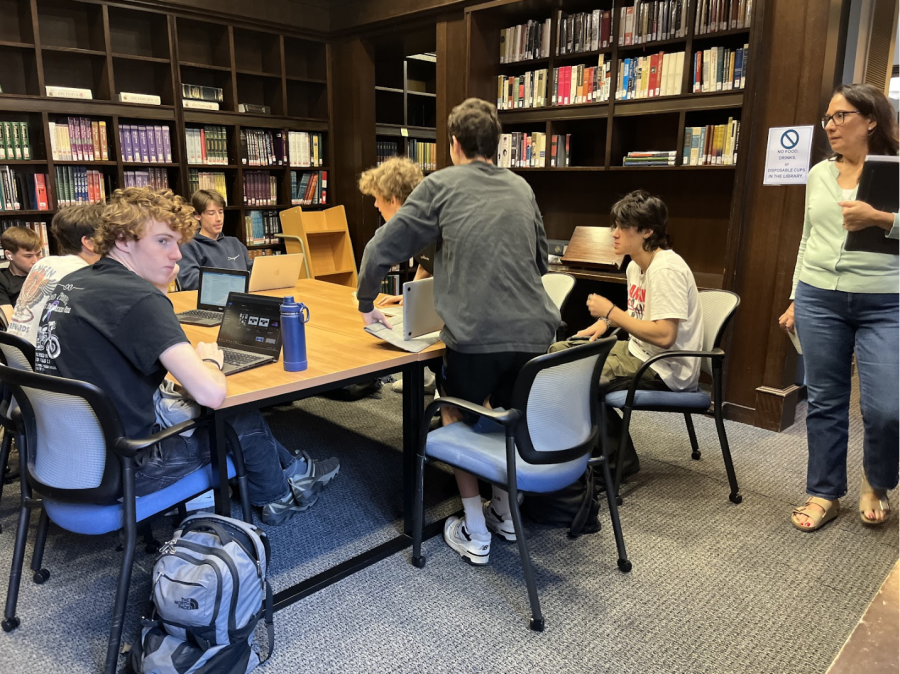Librarians Vs. Students of the Back Room
June 10, 2023
Over the course of this year a feud between librarians and students has been brewing. The back room of Poly Prep’s library, also known as the reference room, has become a popular hangout spot for many of Poly’s students, much to the annoyance of the librarians. The noise levels in the room seem to be a constant issue for the librarians, but their attempts to establish silence in the room prove to be futile time and time again. Many students feel, however, that the treatment they receive from the librarians is unjust and that controlled talking should be allowed. As someone who personally spends a lot of time in the back room, often witnessing the feud between the students and librarians through the year, I sought to hear both the students’ and librarians’ side of the issue.
In one word, Lisa Puleo, a Poly librarian of 15 years, describes the situation in the back room as “chaos.” Ilona Chudner, another one of Poly’s librarians, explained “Usually what happens is that students just go in there and talk.” According to both Puleo and Chudner, the entire library should be a completely silent space, including the back room. “Stay in Commons, or go for a walk outside,” Puleo suggested to students who want a space to talk.
To her, this issue is largely due to the students’ negligence: “For some reason they think that it is soundproof, but we can actually hear everything they’re saying. They just come to talk to their friends; they discuss sports very loudly. It’s very disrespectful to everyone here, because they can be heard all over the library.”
Chudner mentioned that the issue has gone on far longer than just this year and even let me in on a secret trick the librarians use to monitor the room: a covert mirror in the room that can be seen from the librarian’s desk, installed about 10 years ago to keep tabs on how many students are in there from afar.
“I think the issue is so bad because they are behind a wall and most of them don’t realize there is a mirror there,” said Chudner. Puleo said, “The students forget about library behavior when they’re back there. It gets very loud and they even sometimes bring food back there,” which is not allowed in the library. Puleo feels she handles the situation in the back room calmly: “I’ll go back there and talk to them. If it really gets out of hand I’ll ask them to leave, and the people clearly working, I’ll let them stay.” At times, Puleo notices that students who are actually working in the room thank her for making the room a quiet space, and avoids kicking them out.
However, many students have starkly different understandings of the situation. Indeed, some students are outraged at their treatment by the librarians. “They see you smiling and they feel the need to come in and wipe that smile off your face,” said junior Eleni Smith. Some students feel that the room is sectioned off for a reason: “This is a room for people to talk and collaborate,” said senior Mia Gordon. Smith agreed, saying, “There’s doors to the room that block out noise, but when we try to close them they yell at us.”
Smith also feels the librarians are frequently unfair, stating, “They come in and yell when we’re not even being loud. None of the students are even disturbed, it’s just the adults. I’ve never heard a student say ‘oh it’s too noisy in there.’” Other students feel the librarians have become way too sensitive to their behavior in the room. “If I take a sip of my water they’ll come in and kick me out,” joked senior Thomas Collier.
Students also disagree with the librarians’ responses. “If it’s only a couple of kids talking they’ll kick everyone out,” said Smith. There also seems to be a misconception that the students in the room aren’t doing school work: “I’m normally doing work when I’m in here; it’s very rare that I’m not,” said Gordon. Students feel there is also no correlation between how loud students are and the way the librarians react. “One day they’ll be chill, the next day they’ll kick everyone out,” said Smith.
The room is just too valuable to many of the students and despite the librarians’ best efforts, students will not cease their presence in the room. “They can barricade this room up and we will find a way back in here,” joked Smith.
Clearly, just kicking kids out is having no effect on the dramatics of the situation. Indeed, even closing the entire library for a day (which they did earlier this year) has not had lasting impacts. I think the best way to resolve the situation is through a civil discussion between librarians, students and the administration on the appropriate uses of the space. At the crux of the issue is a fundamental misunderstanding between students and librarians on whether the space is a good place for collaborative learning or not.
Although I see both sides of the issue, I personally feel that the issue is best resolved by allowing the students to use the room for collaborative learning purposes and addressing the noise issue through closing the doors or even potentially soundproofing the room. If the noise level does get out of control, I see no problem with librarian or administration intervention. I believe that through these means, as well as clear rules about appropriate uses of the space, students and librarians will be able to reach an unproblematic resolution.
But there is also something undeniably alluring about the room that I don’t think any of the students I interviewed quite mentioned: its booklined shelves, decor that seems to harken back to an earlier era, and walled-off privacy that give off a feel that is not quite found anywhere else on campus, distinct from the frenetic energy of the student center and the silence of the rest of the library. Perhaps if librarians truly want to get students out of the room, similar rooms may have to be installed elsewhere.

























